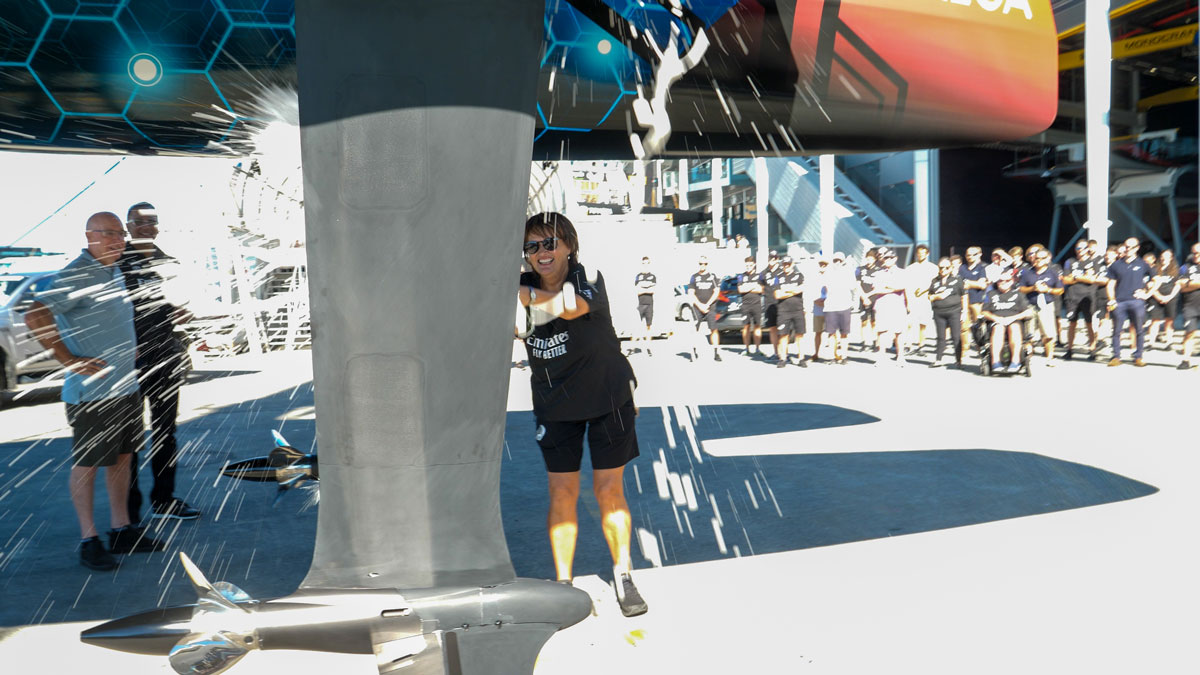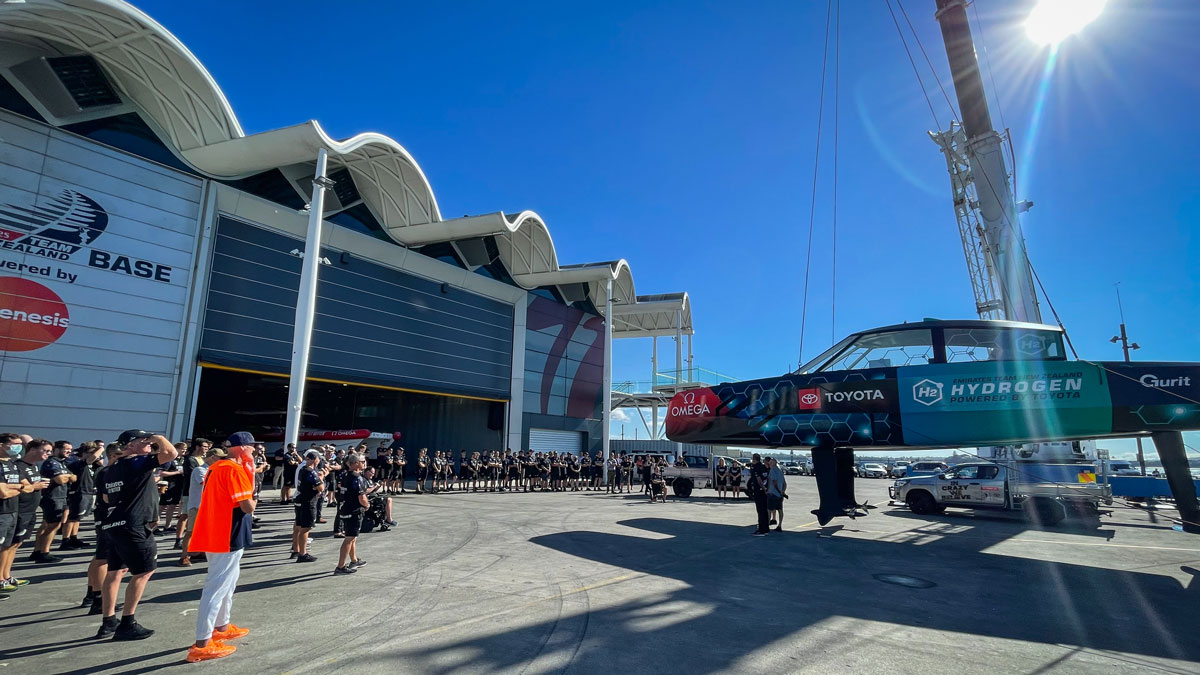Chase Zero, the world’s first hydrogen-powered foiler, promises the speed and range of a petrol-powered sportscruiser with zero harmful emissions. Is this hydrogen boat the answer to sustainable motor boats?
The America’s Cup may be the pinnacle of yacht racing but it’s not the obvious starting point for a revolution in motor boat design.
And yet that’s exactly what the current holders Emirates Team New Zealand (ETNZ) is hoping it will become.
In a bid to make the race more relevant to a wider audience, while limiting the carbon footprint of its high-powered petrol chase boats, it has altered the rules so that any competing team must come armed with at least two hydrogen-powered chase boats.
Given that nobody has yet built a hydrogen boat that can plane let alone do 50 knots, that’s no easy task.
However, by making it part of the protocol, ETNZ hopes to kick-start the industry’s move towards a zero-carbon future.
Article continues below…

Electric boats: A-Z of the 37 best all-electric models

Sanlorenzo owner to build “world’s first hydrogen-powered superyacht”
To prove its point, ETNZ has recently launched its own hydrogen boat and hopes to start sea trials within a couple of weeks. (Update: Sea trials began this week, see the video below).
If all goes to plan Chase Zero will soon be flying above the water on its computer-controlled foils at 50 knots while carrying six crew and emitting nothing but pure water.
And unlike most range-restricted electric boats currently on the market, this electric-engined hydrogen boat has a cruising endurance of 180km (97.2nm) at 35 knots.
How does the hydrogen boat work?
The secret of this 33-footer’s remarkable speed and range is a pair of 80kW fuel cells supplied by Toyota.
Originally designed for use in its Mirai car, these 300kg devices convert the hydrogen gas stored on board into 400V DC electricity by passing it over a catalyst and combining it with oxygen from the air. The only by-product is H2O – pure water.
The electricity this generates is then either stored in a battery or fed directly to the two 220kW (295hp) Emrax electric motors.

The 80kW Toyota fuel cell is lowered into one of the hulls
Like the fuel cells, these are mounted inside the catamaran’s two hulls with driveshafts running down the foil struts to a bevel gear which transmits the power to a pair of Mercury propeller drives.
Why build a hydrogen boat?
The reason for going down the fuel cell route rather than a simpler battery-powered system is due to the superior energy density of hydrogen.
Even with the benefit of foils to reduce drag, ETNZ calculated that it would need 470kWh of energy to meet the typical 4-hour/180km drive cycle of an America’s Cup chase boat.

Each of the four tanks hold 8kg of hydrogen compressed to 350 bar
The batteries needed to store that much energy would weigh 3 tonnes, requiring more power to achieve the necessary performance and tipping the project into a spiral of diminishing returns.
The hydrogen needed to generate that much energy, on the other hand, weighs just 32kg and is stored in four high-pressure carbon-fibre tanks at 350 bar (5,076 psi). Even once you’ve factored in the weight of the tanks and the two 300kg fuel cells, the hydrogen boat still delivers a big weight saving.
It does still need a small battery though, partly due to the lag it takes for the fuel cells to deliver the power required and partly to provide a temporary boost which pushes the fuel cell’s 160kW output up to a peak of 420kW (563hp) for maximum acceleration.

Carbon fibre build and foiling technology from the America’s Cup boat enable 50-knot speed
The other beauty of hydrogen is that as well as being a clean fuel it can be produced sustainably by using electricity to split water back into hydrogen and oxygen. That only holds true if the electricity is also sustainably sourced, of course, but the potential is clear.
Is hydrogen tech adaptable for leisure?
In many ways the case for hydrogen boats is more compelling than battery-powered ones.
The superior energy density and relative abundancy of hydrogen makes it theoretically possible to build hydrogen boats of all different sizes with similar range and performance to the petrol and diesel-powered craft we enjoy today.

The limiting factor is the size and mass of the high-pressure storage tanks required. The solution to this may be denser liquid hydrogen stored at -252°C in thermally insulated tanks rather than more voluminous compressed gas.
You can even burn hydrogen in a comventional combustion engine while emitting no carbon monoxide, although the excess heat this develops will create some NOx emissions and makes it less efficient than a fuel cell (around 30% of the energy is converted into power compared to 50% for a fuel cell).
What are the downsides of hydrogen boats?
Hydrogen boats are not without their challenges, the three main ones being cost, the lack of infrastructure, and safety concerns over the storage and fuelling process of a volatile high-pressure gas.

A hydrogen-powered Toyota Mirai car costs from £49,995, compared to £30,000 for a typical petrol-powered car, although that premium would likely be considerably more for a boat, at least until they were built in sufficient quantities to bring the cost down.
The lack of infrastructure could also be addressed over time and unlike electricity hydrogen can be stored indefinitely and either produced locally in small-scale plants or centrally at solar farms and transported to the point of use.
Safety is harder to quantify, however, as although hydrogen is combustible (witness the Hindenburg disaster) and high-pressure gas systems may be more prone to leaks than a low pressure fuel line, there are plenty of gas-powered cars running around safely and petrol vapour is arguably more dangerous as it sinks to the bottom of the bilges whereas hydrogen is lighter than air and dissipates more easily.

Whatever the pros and cons of hydrogen boats, if ETNZ can demonstrate Chase Zero‘s potential as a viable fossil-free boat fuel, it can only stimulate the development of promising new technologies.
Hydrogen boats may not be the only solution for the future of boating but they will almost certainly be part of it.
First published in the May 2022 issue of MBY.
If you enjoyed this…
Be first to all the latest boats, gadgets, cruising ideas, buying advice and readers’ adventures with a subscription to Motor Boat & Yachting. Available in both print and digital formats, our monthly magazine will be sent directly to your home or device at a substantial discount to the usual cover price. See our latest offers and save at least 30% off the cover price.









